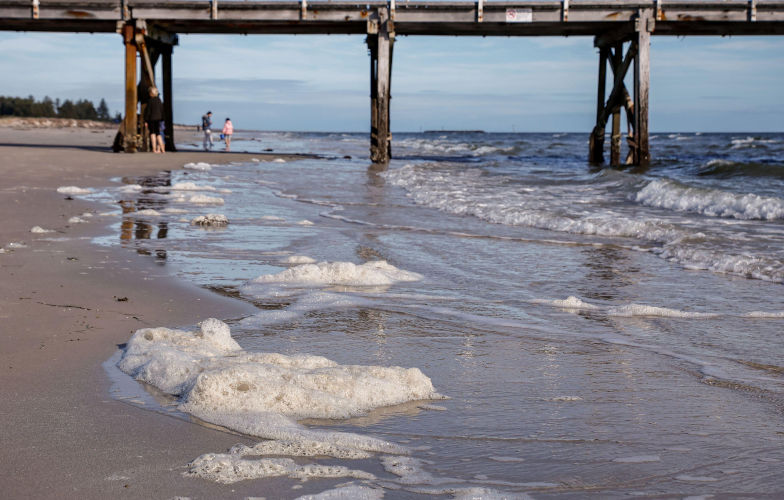Algal bloom: first peoples ngamath-sea country
August 7, 2025
A civilisation that proves incapable of solving the problems it creates is a decadent civilisation. – Aime Cesaire.
Imagine pristine rivers, clean oceans, relief from global warming, and our waterways no longer used by industry to dump its waste. First peoples pre-colonial times lived a non-toxic life. Now we experience genocide, ecocide and juricide of our laws. But what if our ancient laws of this country applied and we had no ecological crises?
First sighted in March 2025 a toxic Karenia mikimotoi algal bloom has spread across the sea country of the Tanganekald, Bunganditj, Meintangk, Ramindjeri, Kaurna, Narunga and other First Peoples’ ngamath or sea countries and extends as far west as that of the Mirning. This algal bloom has killed marine life across the coast, including places now known as the Fleurieu Peninsula, Kangaroo Island and the Coorong wetlands. The algal bloom now covers almost 4500 square kilometres. Thousands of fish, sharks, rays, invertebrates, shellfish, seagrass and dolphins across some 450 species have died and Aboriginal relations to sea country will be impacted by the algal bloom’s destructive reach.
Scientists claim it is caused by a prolonged marine heatwave. A further cause considered is the 2022 floods which flowed through the Murray Darling Basin, collecting nutrient-laden runoff and organic matter on their way, eventually flushing out through the mouth of the river, dispersing the nutrient load into the Southern Ocean. Further, the normal summer “upwelling” of deep ocean water along the southeast coast may have added to the nutrient load. The marine heatwave resulted in sea temperatures rising to 2.5°C above normal; this provided a perfect environment for the bloom to thrive and there is no end in sight.
The South Australian Government called on the Commonwealth minister for the environment Murray Watt to declare the toxic algal bloom event a national emergency. The minister’s response was that it is a problem for the state to fix, and that the event failed to meet the criteria for a national disaster declaration. This is while Murray Basin floods and climate change know no jurisdictional boundaries as water flows across the colonial boundaries of state, national and international jurisdictions.
First people’s sovereignty and ngamath - sea country?
First people’s knowledge of sea country is embedded in law and language; we have cared for country for a very long time before colonial invasion. Australian laws do not protect the natural world from destructive events such as this, as demonstrated in the current algal bloom crisis. International and Australian laws have not addressed climate change adaption fast enough; the algal bloom now happening in our waters is proof of it. Current Australian law is reactive rather than preventive and there is a critical need for stronger national co-ordination and disaster frameworks that are inclusive of sovereign Aboriginal positions. This event should have been sufficient to have triggered a Declaration of a National Emergency and resourcing of a response which would result in measures mitigating the likelihood of a recurrence. In this space, ancient Aboriginal knowledge systems should respectfully, and with free prior and informed consent of sovereign First Peoples, (beyond a colonialist token inclusion) be negotiated with.
However, as is often the case, economic interests take precedence over environmental considerations and protective measures. The Australian legal framework for land and sea protection includes the Environmental Protection and Biodiversity Conservation Act 1999 (EPBC Act), which enables an assessment of actions which could impact water ecosystems and include nutrient run-offs. What actions have the Commonwealth and state governments taken in this regard? The EPBC Act should be used to manage land use and development projects near sensitive waterways to ensure nutrient run-off does not end up feeding marine agal blooms, such as the one which has occurred. In addition, the Water Act of 2007 should oversee the management of Murray-Darling Basin waterways, to limit nutrient-rich run-off.
Meanwhile South Australian laws and regulations include the Environment Protection Act 1993 (SA), which prohibits the discharge of pollutants including nutrients, sediments and wastewater without EPA approval. The Environment Protection Water Quality Policy of 2015 specifies the acceptable nutrient discharge limits. Was any work during the Murray flood of 2022 done to measure or mitigate nutrient discharge in South Australia? The Landscape South Australia Act 2019 governs land, water and biodiversity management through regional landscape boards. They are responsible for catchment management to reduce nutrient runoff into rivers and onto coasts. Where are these boards in the mix of things? The Fisheries Management Act 2007 (SA) allows the closure and restriction of aquaculture and wild harvests when algal toxins are detected and is used to manage shellfish safety and fishery access during bloom events. South Australia’s Water Quality Monitoring Framework does support early warning systems for harmful algal blooms, and regulations under the Aquaculture Act 2001 control feed, waste and site locations to minimise nutrient loading. The Marine Parks Act 2007 “protects” sensitive marine ecosystems.
So, what failed, and why the crisis? Decades of climate change denial was a failure. Weak environmental state, national and international law is a failure, while the over-exploitation of our natural world propels it further. The failure to act on climate change will fuel the growth and spread of toxic algal blooms. In complete denial of any connection between marine heatwaves and carbon emissions, Watt approved the Woodside plant expansion soon after his ministerial appointment; this was characterised by the chief executive of the Australian Conservation Foundation, Kelley O’Shanassy, as the equivalent to releasing a “carbon bomb”.
The knowledge and laws of first peoples are absent in this space, while our efforts to prevent the genocide of peoples and the ecocide of our land and ngamath-sea countries are ignored. The images of a dying ngamath are a call to action.
The views expressed in this article may or may not reflect those of Pearls and Irritations.
